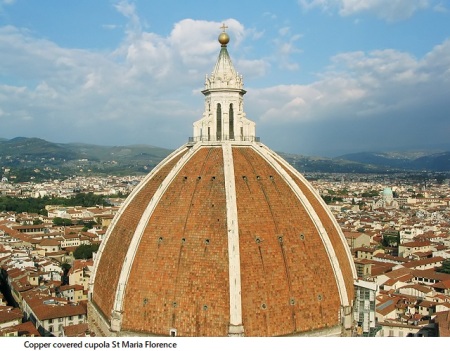Post 379 – by Gautam Shah
.

Roofs of buildings have been formed of smaller components such as ceramic tiles, slate stones, stone slabs, and grasses (thatched) or of masonry domes. Leakage of water and air were chief problems. These were solved by provision of acute slopes for drainage, design of joints, and use of joints’ sealants. Other problems included structural integrity against vibrations (earthquake and usage), accommodation of stresses (thermal, wind and loading) and maintenance through repairs and replacement.



Metals are the lightest and thin body materials for roofing. Lead and copper, have been most widely exploited-metals, till coated steel products became available. Metals are used for roofing elements such as for main body cover, flashing or joint making, and drainage system including, gutters, spout and pipes. A metal roofing system can have all components made from different metals. Such multi metal systems are used for mechanical advantages of installation but not for galvanic protection. Performance, maintenance, service life, and recovery costs determine the cost effectiveness of metal roofing components.
Copper has been a favoured roofing material for two main reasons: 1. It is fairly durable when it can form bluish-green patina and, 2. It can be bent, stretched or moulded into difficult -doubly curved shapes. Copper sheets used for roofing are easy to shape over curved structures such as cupolas and domes. Copper roofing sheets can be forged joined for greater lengths. Copper sheets or panels are lighter than wooden shingles, and much lighter than slate, ceramic tiles, or stone slabs.

Copper roofs are prone to galvanic erosion, unless isolated from other conductive elements. Copper is a universal roofing material as it is used for cover, gutters, flashing, coping and spouts. Copper is an ideal for flashing as it is malleable and easily workability, solder-able with tin, and is resistant to Alkaline environments. It is easy to hammer or work into watertight joints, without any caulk or the gasket. Copper is reusable material.

Copper roofing system is essentially how joints are formed. One of the simplest ways is to create a lapped joint with a soldered rim. But such a joint of tin, may not architecturally match the green-blue patina. So, concealed seam joints filled with a tin solder lining are preferred. To accommodate the seam thickness, the joints are used for nailing to batten and the seam folded over to form horizontal steps or vertical line marks. For flatter or low-pitched roofs the seams are folded downward and the groove filled with a solder or caulking compound.

A copper roof can stain adjacent building materials of lighter colours. Lead-coated copper can result in a black or gray stain. Proper design can avert such a situation. It may not be necessary to isolate copper from lead, tin or many stainless steels under most conditions. Some isolation can be achieved by using coatings including paints.

Metal roofs do not add to risks of lightning strikes, as the metal disperses the electricity throughout the structure, lowering the damage by flash fire.


.
